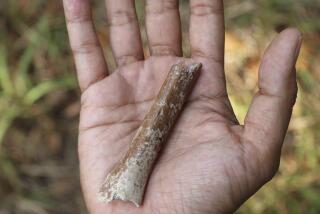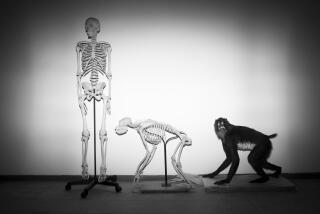Human/Ape Link--Missing No More? : African fossil excites scientists seeking the answer to a longstanding evolutionary mystery
- Share via
A basic tenet of evolution is that modern human beings descended from the same ancestor as modern African apes. But fossil evidence making this crucial link has been missing. Now an exciting new discovery of teeth and bones of 17 members of a heretofore unknown human-like species that lived in central Ethiopia 4.4 million years ago comes tantalizingly close to establishing this missing link.
These creatures appear to have lived close in paleontological time to the fateful ancient divergence of apes and humans. The finding is all the more exciting in that it tends to support the genetic argument of molecular biologists that this divergence occurred much more recently than previously thought, perhaps only five million or six million years ago rather than 15 million to 20 million years.
The scientific implications of all this are enormous. They certainly give no support to those still tempted to believe the explanation of “creation science” that Homo sapiens emerged full-blown on Earth just a few thousand years ago. We need not expend too many words on this bogus “science.” While there remains scientific debate about the processes by which it occurred, Darwinian evolution is a theory that has been confirmed beyond doubt.
Until now, the earliest known hominid--or human-like creature--was the species Australopithecus afarensis , exemplified by the 3.2-million-year-old skeleton nicknamed Lucy and found nearby in Ethiopia in 1974. The new species, dubbed Australopithecus ramidus , is smaller and more like the modern chimpanzee than Lucy. But the shapes of the cranium, teeth and elbow show unequivocally that it had begun to evolve away from the apes.
The new findings, given the fragmentary nature of the fossils, leave many crucial questions unanswered. Did A. ramidus walk upright? Also, the fossils were found in what was once a thickly forested area rich with monkeys, birds, otters, antelopes and other vertebrate animals. What does that do to the theory that hominids developed as a natural-selection response to climate changes that produced grasslands and open country? If further digging turns up hip and leg fragments showing this forest creature to have been a biped, that will certainly spur much rethinking of the evolutionary process.






